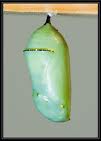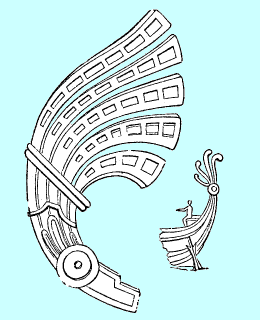Puppis is the Stern or the poop deck of the Ship Argo Navis. Puppis is from Latin puppis, ‘stern, poop’, French poupe, from Old Provencal poppa. The word puppis was also used in Latin as a standard word for ‘ship’, but technically it refers to the rear deck of the ship which is the poop deck, the afterpart of a ship.
The word stern derives from Indo-European *sta, the base of a long list of derivative words. In sailing ships the steerage was always located at the stern. The words stern, steer and starboard (steerboard) comes from Germanic *steuro, ‘a steering’ (from Indo-European *sta-).
“The stern (puppis) is the rear part of a ship, as if the term were post (literally ‘after’).” [The Etymologies of Isidore of Seville, 7th century AD, p.374.].
The word post, ‘after’, derives from *apo-. [The word post, a post used in steering, is from the same root as stern; Indo-European *sta-]. Pokorny also makes a tentative connection with Puppis on this page under “Root / lemma: apo (po, ap-u, pu)” “quite uncertain Latin puppis `the poop or stern of a vessel; poetically the whole ship’. Maybe Albanian pupa `the poop or stern of a vessel’ : Polish pupa `bottom’.” Derivatives of the Indo-European root *apo-: apo- Also ap-. Off, away. of, off, offal, ebb [outgoing tide], from Old English ebba, low tide; ablaut (change of vowel in indo-european), from Old High German aba, off, away from; aft, abaft, from Old English aeftan, behind, from Germanic *aftan-. ab-, from Latin ab, ab-, away from. apo-, from Greek apo, apotheosis – to change into a god; after, from Old English aefter, after, behind, from Germanic *aftar-. eftsoons (soon after), awkward, from Old Norse ofugr, turned backward, pogrom, post, post-, posterior, posterity, postmortem, preposterous, puisne (lower in rank, literally born later – puis, later, and ne born), puny, from Latin post, behind, back, afterward, apposite, apposition, apropos, component, compose, composite, composition, compost, compote, compound, contrapposto, depone, deposit, dispose, exponent, expose, expound, impose, imposition, impost, interpose, juxtapose, oppose, opposition, opponent, pose, position, positive, post, post [post office, delivery of mail ], postiche, pospone, posture, preposition, propose, provost, punt (to lay a bet against the bank, as in roulette), purpose, reposit, suppose, transpose, from Latin ponere, to put, place, from *po-s(i)nere (sinere, to leave, let; of obscure origin), depose, propound, repose, supposition, apostacy [apo– + histanai, to stand, place]. [Pokorny apo– 53.]
There is a suggestion by Richard Stoney that “the name Apollo might have been derived from a pre-Hellenic compound apo-ollon likely related to an archaic verb apo-ell-, literally meaning ‘he who elbows off’, and thus ‘The Dispelling One’. []”
Naos is the name of the zeta (ζ) star in Argo Navis, now located in the constellation Puppis. Greek naos means “ship”. NationMaster gives another meaning; “Naos, from Greek naos, is also a term used in classical architecture to refer to the inner chamber of a temple which houses an idol. In the Ptolemaic period in Ancient Egypt, the Naos referred to that which is hidden and unknown inside the inner sanctum of a temple, existing in complete darkness, meant to symbolize the state of the universe before the act of creation.”
“The name Puppis came from the Middle English poupe, from the Latin puppim, meaning the rear section of a ship. The word derived from the Latin Puppis, meaning a doll or small image, the Romans and other ancient seafaring peoples had a small sacred idol or image affixed to the stern, where the deity it represented could watch over the vessel” [A Glossary of Nautical Terminology].
Latin has pupus, boy, and pupa meaning both girl and doll, the diminutives of these words were pupillus, children or male children, and pupilla, female children. The word pupil, a child in school, Latin pupillus, or Old English pupille, did not emerge until the 16th century; it originally meant ‘orphan, ward’, literally ‘little boy’, diminutive of pupus. According to Klein; pupil is related to pupa, puerile, puppet, and puppy. [Puppis, is adjacent to Canis Major, the Greater Dog].
While the word pupil, a child in school, an orphan, had more of a male connotation, there is an almost universal idea of associating the pupil of the human eye with a little girl or doll. In its anatomical sense, pupilla is a loan translation of Greek kore ‘girl; pupil of the eye’ []. The pupil of the eye was so called from the little images (‘puppets‘), which appear in it. If you look into someone’s eyes you can see a tiny doll-like image of yourself in the black pupil

 Latin pupa means girl, doll, and also pupa or pupate, the chrysalis stage, or nympha, in butterfly metamorphosis, the resting stage between caterpillar and butterfly (pupa is applied only to butterflies, not to other insect’s cocoons). In some representations of ancient ships a kind of roof is formed over the head of the steersman, and the upper part of the stern frequently has an elegant ornament called an aplustre (probably from the above I.E. root *apo-, + lustrare; luster, illustrate), which constituted the highest part of the poop. A lantern was suspended from the aplustre so as to hang over the deck before the helmsman [], and to serve as a signal at night. Pupae or pupa, is lantern shaped and is suspended from a twig like a hanging lantern, they have been referred to as lantern-like pupa, or larval lanterns.
Latin pupa means girl, doll, and also pupa or pupate, the chrysalis stage, or nympha, in butterfly metamorphosis, the resting stage between caterpillar and butterfly (pupa is applied only to butterflies, not to other insect’s cocoons). In some representations of ancient ships a kind of roof is formed over the head of the steersman, and the upper part of the stern frequently has an elegant ornament called an aplustre (probably from the above I.E. root *apo-, + lustrare; luster, illustrate), which constituted the highest part of the poop. A lantern was suspended from the aplustre so as to hang over the deck before the helmsman [], and to serve as a signal at night. Pupae or pupa, is lantern shaped and is suspended from a twig like a hanging lantern, they have been referred to as lantern-like pupa, or larval lanterns.
The words stern, steer and starboard (steerboard) are related. There might be some ultimate relationship between the English words stern (of a ship), and star (a celestial body) from German stern, Latin stella. Puppis is the stern of Argo Navis, built by Argus; Argus’ many eyes represent stars [], and whose eyes after he was killed were placed on the tail of the peacock Pavo, representing the whole starry sky. Puppis is the back part of the ship from where the helmsman steered by viewing the course of the stars. Manilius explains the connection between stars and pupils of the eyes from the ancient’s point of view:
“… triumphantly directing to the stars his [man’s] star-like eyes, looks ever more closely at Olympus and inquires into the nature of Jove [God] himself; …. and in his quest of a being akin to his own, seeks himself among the stars. … thus the tiny pupil of the eye takes in the whole of the heaven and their eyes owes their vision to that which is very small whilst what they behold is very large”. [Astronomica, Manilius, 1st century AD. p.295 and 297.]
Puppets carry a mystic meaning relevant to this celestial feature; that we may be controlled by the stars like puppets on a string. Penguin Dictionary of Symbols explains what was believed about puppets:
“The Mahabharata has the words: ‘Human behavior is controlled from the outside like that of a wooden doll on the end of a string.’ And in the Upanishads there is: ‘Do you know the thread by which is attached this world and the other and all the beings in them, and the hidden Master who controls them from within?’ When the craving for the One is satisfied, the human will be absorbed in Plato’s golden thread which governs us, puppets that we are. Plato said that, by virtue of all that is best in it, mankind is the plaything of God, while Jacob Boehme wrote: ‘You will achieve nothing until you abdicate your own will, that is, what you call ‘I’ or ‘myself’.’ Ananda Coomaraswamy conjures up the ecstatic rapture of the puppet ‘acting without action’ in the sense taught by the Bhagavad Gita and the Taoist doctrine of wi wu wi. Freedom is not to be gained by uncoordinated movement, but by becoming aware that in joining in ‘the dance of phenomena’ we may identify with the puppet-master who controls us.” [The Penguin Dictionary of Symbols, p.774.]
© Anne Wright 2008.
| Fixed stars in Puppis the Stern | |||||||
| Star | 1900 | 2000 | R A | Decl 1950 | Lat | Mag | Sp |
| nu | 15CAN46 | 17CAN09 | 099 03 27 | -43 09 04 | -66 04 49 | 3.18 | B8 |
| tau | 26CAN21 | 27CAN44 | 102 10 26 | -50 33 16 | -72 51 29 | 2.83 | G8 |
| pi | 28CAN56 | 00GEM19 | 108 50 39 | -37 00 24 | -58 31 49 | 2.74 | K5 |
| 02LEO03 | 03LEO26 | 108 00 11 | -44 33 27 | -65 58 08 | var | M5 | |
| 02LEO05 | 03LEO28 | 114 11 35 | -26 41 13 | -47 25 04 | 4.50 | B8 | |
| Azmidiske xi | 04LEO39 | 06LEO02 | 116 47 51 | -24 43 59 | -44 56 40 | 3.47 | G6 |
| sigma | 07LEO19 | 08LEO42 | 111 54 39 | -43 11 58 | -63 46 54 | 3.27 | M0 |
| rho | 10LEO01 | 11LEO24 | 121 21 12 | -24 09 32 | -43 16 29 | 2.88 | F5 |
| Naos zeta | 17LEO10 | 18LEO33 | 120 27 24 | -39 51 41 | -58 21 06 | 2.27 | O5 |